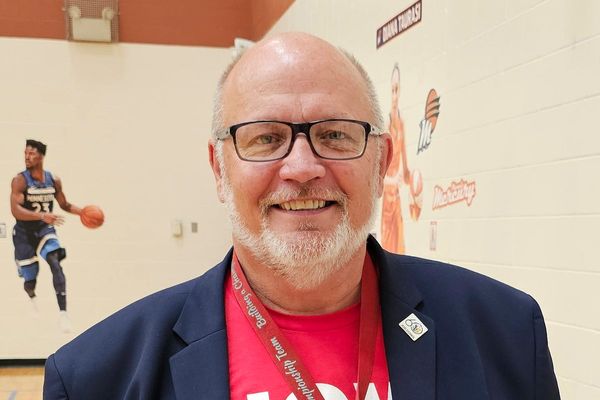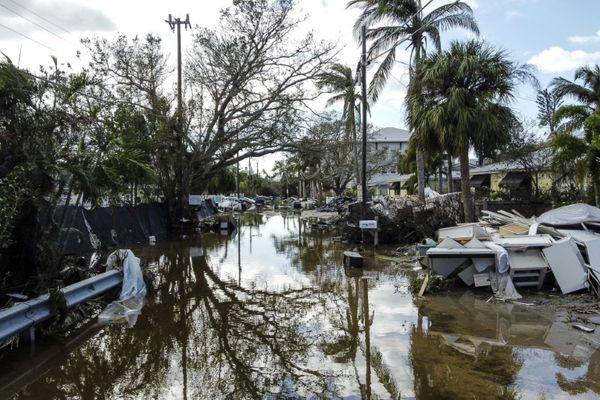
If an asteroid were to gain sentience and set a course for Earth, might it pick a time like the holidays in order to catch the humans off guard? Well, that’s not going to work: Someone is monitoring space for incoming objects, holidays or not.
Kelly Fast manages the Near-Earth Object Observations Program at NASA’s Planetary Defense Coordination Office, which funds observatory teams at U.S. institutions using telescopes located around the world. And yes, she told me, researchers monitor the night sky even when most of the country has the day off.
Fast and I discussed the program and the day-to-day work of keeping the planet safe from asteroids.
Our conversation has been condensed and edited for clarity.
Caroline Mimbs Nyce: When we talk about looking for asteroids—or near-Earth objects—what does that mean?
Kelly Fast: It’s astronomers using telescopes. What they’re looking for are objects that look like stars but are moving relative to those background stars. And then they report those observations.
You have a number of telescopes, like the Catalina Sky Survey at the University of Arizona and Pan-STARRS at the University of Hawaii, that NASA funds to search for near-Earth asteroids. They do that survey every night—or every night that they can. Things like weather or the full moon can be a problem. But that’s why it’s nice having a number of telescopes, because someone can always be looking, even if the sky is cloudy in one location.
Nyce: Is a full moon just too bright?
Fast: Right. It just makes the sky bright. And so, if you’re looking for fainter objects, it kind of overwhelms them. But only the area of sky right around the full moon is a problem.
We have a network of telescopes doing that search effort. And all of them report their observations of moving objects to the Minor Planet Center, which is funded by NASA but is the internationally recognized repository for natural-object, small-body position measurements of all kinds—not just near-Earth asteroids. Everybody reports their measurements there. And if there is something that isn’t already associated with an object that’s already known, then it’s put on the near-Earth-object confirmation page at the Minor Planet Center.
Other astronomers can go and look there and see what needs additional observations. It’s one thing to have spotted something that might be a new asteroid discovery, but if you don’t get enough information on it—enough positions to be able to calculate an orbit and figure out where it’s going to be in the future—then that doesn’t help you much.
Nyce: When you do identify something, could it also be falling space junk?
Fast: Or, really, space junk in orbit. Or operating satellites. But that gets weeded out to the extent possible based on what’s available in public catalogs. Plus, often, they move at different rates.
It’s for the Minor Planet Center to make that determination, because they take those observations and determine an orbit from it. And from that they can tell, Oh, this is in orbit around the sun. This isn’t an Earth-orbiting satellite.
Nyce: How close is “near Earth”?
Fast: The definition of a near-Earth asteroid is any asteroid with an orbit that brings it within about one-and-a-third of the distance from the sun to the Earth. But not all near-Earth asteroids actually come close to Earth’s orbit. And so there’s a subset of those that we’d really want to keep an eye on—that if it were to be in the same place at the same time as the Earth one day, we’d want to know well ahead of time.
NASA also funds the Center for Near-Earth Object Studies at the Jet Propulsion Laboratory. They look at all those data at the Minor Planet Center, and do a precision orbit determination way out into the future to see if anything could pose a long-term impact threat to Earth. The goal is to find something that maybe poses a threat years or decades in advance.
Nyce: It sounds like we have a little bit of lead-up time to figure out where they’re going and where they might come into the Earth.
Fast: That is certainly the goal. But there is always the chance that something could be discovered maybe in the short term. But probably very small. You can see most of the large objects much farther away, maybe many orbits ahead of time. But it can happen. We actually had an impactor just a few weeks ago.
Nyce: Oh, really?
Fast: Well, we’re talking very small. The nice thing about our atmosphere is it does a good job of disintegrating small objects. You just see a pretty shooting star or fireball. That happens all the time.
Technically, an asteroid, as defined by the International Astronomical Union, is a natural object larger than a meter in size. Our atmosphere takes care of objects that are that size very easily. The one we had a few weeks ago, 2022 WJ1, was discovered in space before it impacted. And that’s only happened, like, six times before—where an object was discovered in space and linked to an actual fireball seen in Earth’s atmosphere. One of them, a number of years ago, was on New Year’s Day. The universe doesn’t care that we have holidays.
I know you were interested in who’s on the watch over the holidays. The nice thing is it’s not just one person; there are teams of people and a lot of automated systems that do orbit determination and then flag if there’s something that should be an alert.
If you read about the object just a few weeks ago, that’s exactly what happened. A telescope reported the data. Minor Planet Center put it on the confirmation page. And then the Scout system, which was developed by the Center for Near-Earth Object Studies at the Jet Propulsion Laboratory, flagged it and said this has a chance of impacting. And so then there were more observations taken, and the impact region was narrowed down. And then the fireball was seen—a nice exercise of the system.
Nyce: You said we’ve had only six that we’ve been able to connect from to the fireball actually in the atmosphere? Are there other ones that slip through?
Kelly: Well, these objects are very small—just a couple of meters in size—and they’re not the ones that NASA is tasked to try to discover, and certainly not ones that we need to warn people about. We end up treating it like an exercise. It’s not that others slip through. They are taken care of by the atmosphere anyway.
We’d certainly want to warn about something much larger. In the case of the Chelyabinsk impact in Russia back in 2013, that was a much larger object, probably about 20 meters in size. But it was coming from the direction of the sun, from the daytime sky. So it wasn’t something that could be warned about ahead of time. And it wasn’t one that was known many orbits ahead of time. And so that was one that did catch everyone, because there was no way to see it.
Nyce: So there are still surprises in your business?
Fast: Right. NASA is tasked by Congress to find these objects, specifically near-Earth asteroids 140 meters in size and larger—a size that can have regional consequences should one impact the Earth. Obviously, NASA wants to find objects of any size that could hit the Earth, but this is the task Congress has assigned.
NASA’s been looking for ways to kind of speed up the discovery of near-Earth asteroids, because we keep finding objects of that size and larger. And people who do models of the asteroid population can tell that there are more out there that we haven’t found. So NASA is working on a mission to help speed up the discovery of near-Earth asteroids. And it’s called the Near-Earth Object Surveyor. It’s a space telescope that works in the infrared, and it’s very specifically designed to search for near-Earth asteroids. It would be able to look in parts of the sky closer to the direction of the sun, for instance, than what the telescopes on the ground can do.
It’s going to be a very powerful way to speed up the discovery of these objects. Maybe we’ll find none of them pose an impact threat. And that would be fabulous. And maybe we find that one could pose a threat, and it’s years in the future, and that would give time to learn more about it—maybe plan, if needed, a deflection mission. The goal is to not be in a scrambling situation but to have the luxury of time.
Nyce: How much can be done by humans? Are asteroids a solvable problem by mankind?
Fast: An asteroid impact is the only natural disaster that could be avoided because mankind can do something.
The DART [Double Asteroid Redirection Test] mission [during which NASA flew a spacecraft into an asteroid and changed its orbit] was fabulous, because that was just a test just to try it out. It’s physics. If you want to deflect an asteroid, the simplest way is to impact it and change its velocity so that its orbit changes. This was very small scale, and it was done in a test situation with a binary asteroid, because it was just changing the orbit of one asteroid around another. It was very successful. We can use these data to help inform, should we ever have to design a larger mission. That was a big milestone, to have gone from just doing calculations for how you could deflect an asteroid to an actual mission test.
As for the large or multi-kilometer-sized near-Earth asteroids that would pose global consequences, we’re not as concerned about those, because most of that population has been discovered. And so that population is a lot better understood. At the other end of the spectrum, as I mentioned, there are these small, couple-of-meter-sized asteroids that don’t make it to the ground intact.
It’s that intermediate range that wouldn’t have global consequences but could still do some serious regional damage. And so, we’re working on that population. How do you eat an elephant? One bite at a time.







